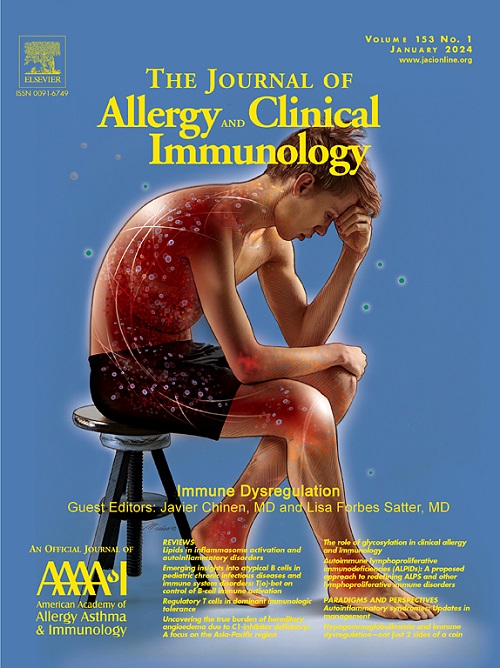慢性自发性荨麻疹和血管性水肿的内分型。
IF 11.4
1区 医学
Q1 ALLERGY
引用次数: 0
摘要
目前对慢性自发性荨麻疹(CSU)的认识表明,其发病机制涉及一个复杂的炎症通路网络。最近的发展突出表明,自身免疫是 CSU 的关键致病机制之一。目前已确定了两种内型,即 I 型自身过敏型(与针对自身抗原的 IgE 抗体有关)和 IIb 型自身免疫型(由针对 IgE 或其高亲和力受体(FcεRI)的 IgG 自身抗体介导)。一部分患者的两种内型重叠。约10%的CSU患者仅表现为血管性水肿。孤立的肥大细胞介导的血管性水肿患者具有明显的临床和人口统计学特征,应与缓激肽介导的血管性水肿区分开来。总 IgE 水平和 IgG 抗甲状腺过氧化物酶等多种潜在生物标志物已被确定,它们与相应的内型一起与疾病的严重程度、持续时间和对治疗的反应相关联。目前,由于可供选择的治疗方法很少,这些生物标志物在临床上的作用有限。不过,随着新型疗法的出现,对 CSU 进行内分型可能有助于调整治疗方法。本文章由计算机程序翻译,如有差异,请以英文原文为准。
Endotypes of Chronic Spontaneous Urticaria and Angioedema.
The current understanding of chronic spontaneous urticaria (CSU) suggests that a complex network of inflammatory pathways is involved in its pathogenesis. Recent development highlighted autoimmunity as one of the key pathogenic mechanisms of CSU. Two endotypes, type I autoallergic (associated with IgE antibodies against autoantigens) and type IIb autoimmune (mediated by IgG autoantibodies against IgE or its high affinity receptor (FcεRI), have been characterized. A subpopulation of the patients has an overlap of the two endotypes. About 10% of patients with CSU presents with angioedema only. Patients with isolated mast-cell mediated angioedema have distinct clinical and demographic features and should be distinguished from bradykinin-mediated angioedema. Multiple potential biomarkers such as total IgE level and IgG anti-thyroid peroxidase have been identified, and together with the corresponding endotypes, have been linked to disease severity, duration and response to treatments. Currently, the utility of these biomarkers is limited in clinical settings given the few options of therapy. However, with the advent of novel treatments, endotyping CSU might help with tailoring treatment approach.
求助全文
通过发布文献求助,成功后即可免费获取论文全文。
去求助
来源期刊
CiteScore
25.90
自引率
7.70%
发文量
1302
审稿时长
38 days
期刊介绍:
The Journal of Allergy and Clinical Immunology is a prestigious publication that features groundbreaking research in the fields of Allergy, Asthma, and Immunology. This influential journal publishes high-impact research papers that explore various topics, including asthma, food allergy, allergic rhinitis, atopic dermatitis, primary immune deficiencies, occupational and environmental allergy, and other allergic and immunologic diseases. The articles not only report on clinical trials and mechanistic studies but also provide insights into novel therapies, underlying mechanisms, and important discoveries that contribute to our understanding of these diseases. By sharing this valuable information, the journal aims to enhance the diagnosis and management of patients in the future.

 求助内容:
求助内容: 应助结果提醒方式:
应助结果提醒方式:


